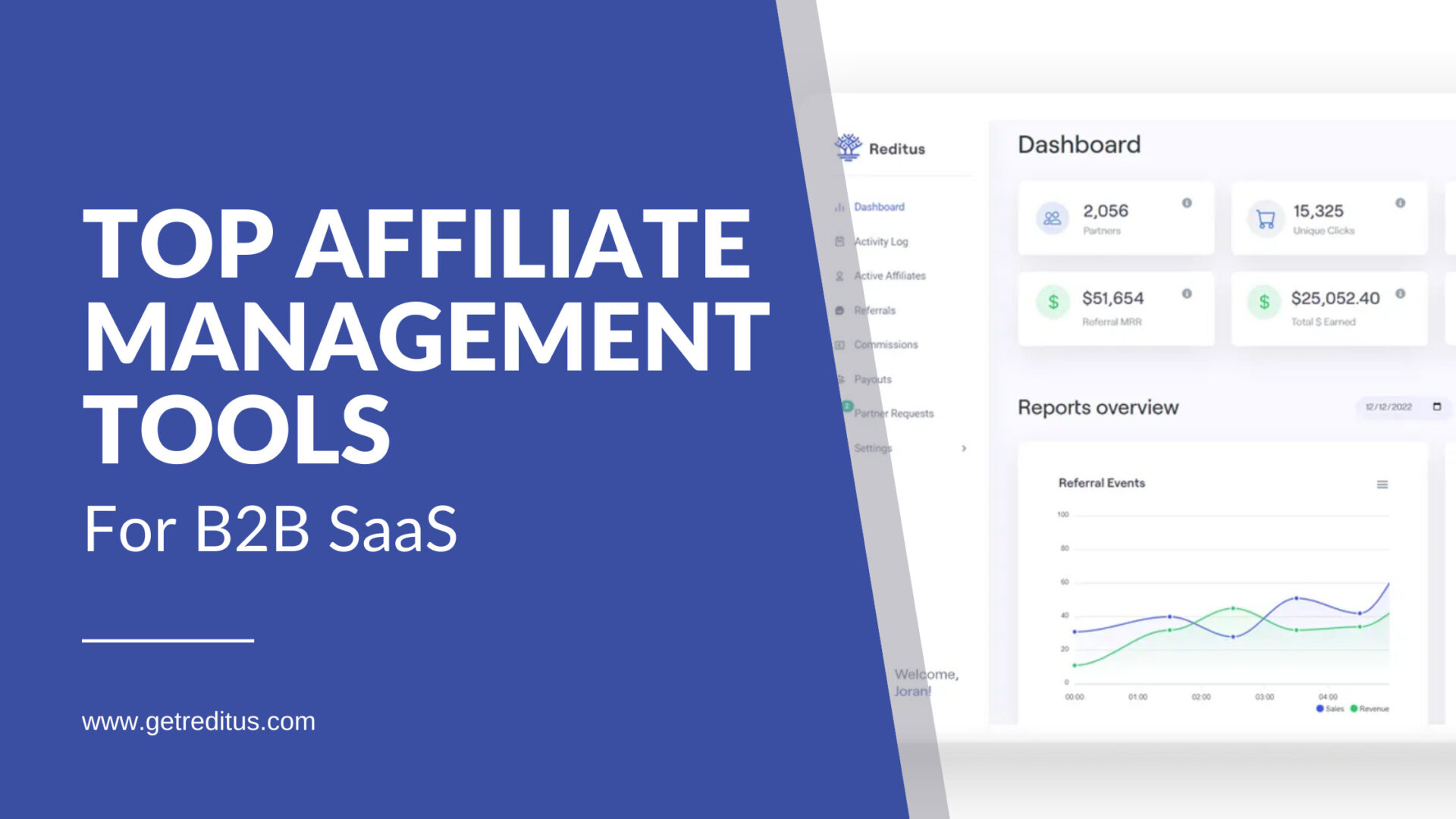Full guide: Setting up a SaaS affiliate Program
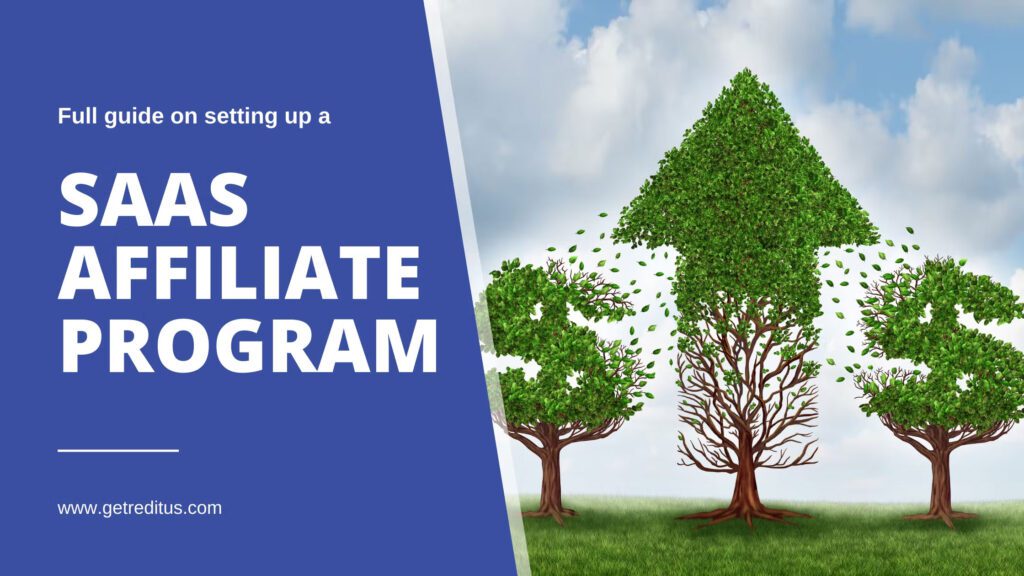
Growing a SaaS affiliate program can be a time-consuming project, in this blog, we will show you how to set up an affiliate program without spending a lot of time or resources.
This guide will work for everyone who is looking to set up an affiliate program for their Saas, but also if you already have one and looking to grow it out more.
It has been proven that a SaaS affiliate program is able to boost your business revenue a lot, and the programs from Hubspot & SEMrush are two great examples of how they helped them grow to where they are today.
We would recommend taking a look at all the steps to kickstart your affiliate program, even if you already are using a partner management tool we do recommend checking the full guide. It will show you the different types, how to define your program details, motivate partners, measure success, and more.
Table of contents
Identify your Ideal Customer Profile (ICP)
Before discussing SaaS Affiliate Marketing, ensure you have a clearly defined Ideal Customer Profile.
An ideal customer profile (ICP), also known as an ideal buyer profile, describes the perfect customer for the concern that your company addresses. The individual/company has all the characteristics that make it the ideal fit for your solutions.
You have a SaaS that you intend to sell, so you must reach out to your ICP. It's good if you have the list ready; if not, you must direct your efforts in that direction to gain maximum traction.
Last thing before we will dive in; we will be using some SaaS terms which you might not know all the time, we would recommend checking out this blog if you don’t know some of the terms; SaaS terms.
What is a SaaS Affiliate program?
First of all, it is good to explain in short what is a SaaS affiliate program and its different kinds. It is a way of marketing your Software where you pay per performance, meaning you only pay when you receive paid clients. This makes it a profitable marketing channel when implemented right.
Understanding Direct and Indirect Marketing Channels
There are two ways to market your SaaS product.
- Direct Channel: Here, you reach out to your clientele directly.
- Indirect Channel: This has one or more than one intermediary between you and your ICP.
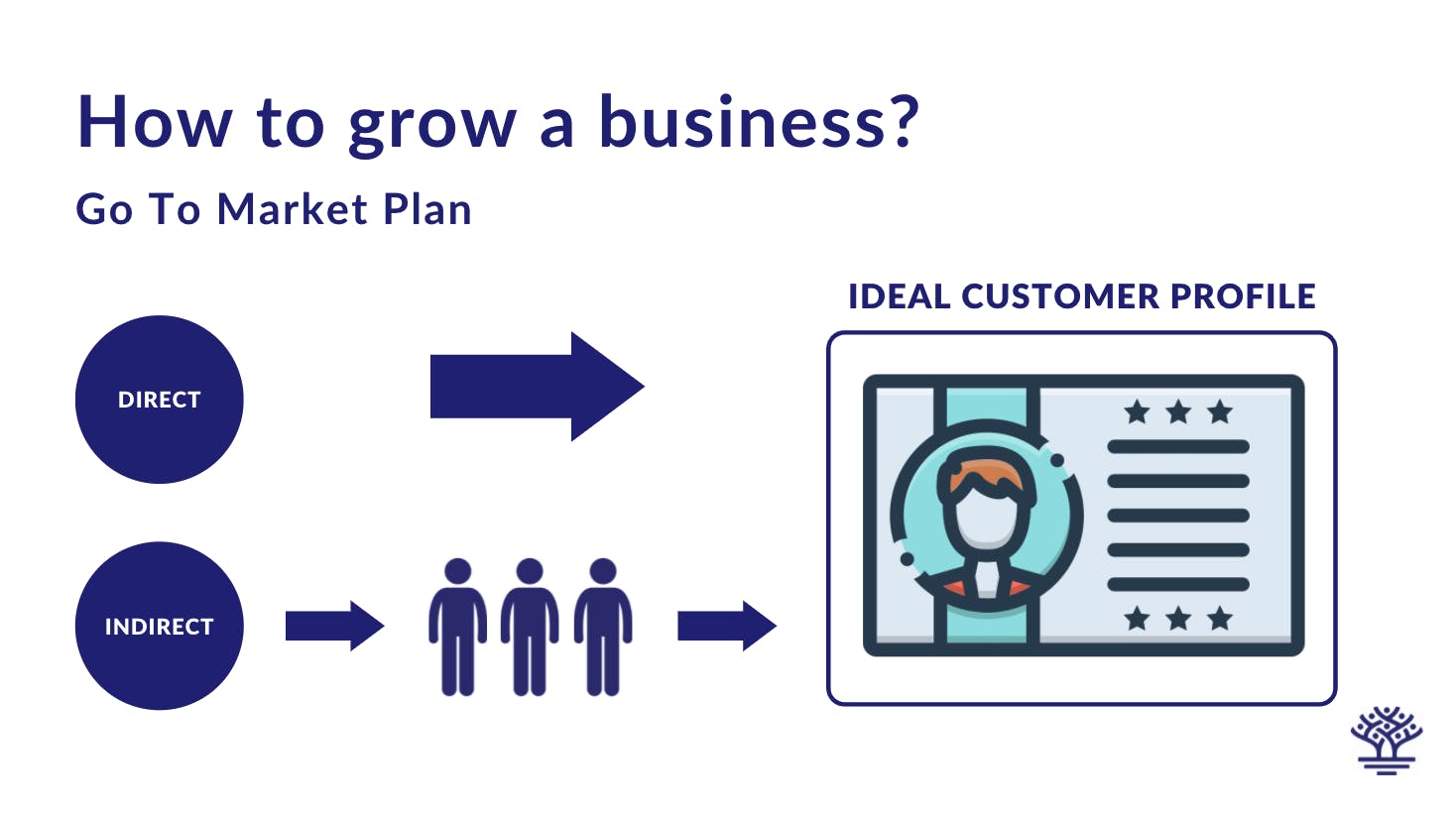
Under the Direct Distribution channel, the following promotional means are covered. You can incorporate these and use them to your advantage:
- SEO
- Paid Adverts
- Outbound Sales
- Social Media
Strategy to go about it
- Hire content writers
- Allocate and utilize Ad budget
- Hire Sales Team
- Hire Marketers
So, let's say you are running ads- now, these adverts will be created by you and will be used in the paid promotion to reach out directly to your ideal prospects.
Speaking of the Indirect Distribution channel, the following marketing means are incorporated
- Affiliates
- Agencies
- Partners
Now, these are third-party promotional channels where some influencers, vloggers, bloggers, YouTubers, etc., are roped in to act as an intermediary for promoting your SaaS product to attract your ICP.
So when you look at the model of partner marketing for SaaS, it means that you will be working with people outside of your own company. They will start doing the marketing for you in exchange for a commission. We will dive into it more but often you can distinguish partners of your company into three categories;
SaaS Affiliate Partners
These are people who are marketing your business in exchange for commissions. You can often find bloggers, influencers, consultants, deal/coupon sites, and review sites in this category. They often care about ‘volume’, meaning they want to attract as many people to their site and divert them to your website.
As they often don’t talk to the end client these ‘partners’ get the lowest percentage, as you will take over when their referrals sign up. Your sales process remains the same and the affiliate for your SaaS will often not have any contact with their referrals. When you are in the EU we would recommend hiding the emails to these partners, to comply with the GDPR regulations.
SaaS Reseller / agencies
Unlike the affiliate partners, they will talk to their clients and will do things for them, this varies depending on the industry you are in. As an example, a marketing agency will work with their clients on a weekly or monthly basis. When you close a partnership deal with them, they often will have clients who they can sign up to your software right away.
Besides that they will have clients lined up, they might also take care of the implementation & onboarding of the software you offer. This means that the sales process will be different, as some agencies do not want you to reach out to the end clients. Make sure you keep this in mind when their referrals come onboard.
SaaS agencies sometimes care less about the commission, their goal is to make sure their client achieves their goals. Some agencies would prefer their clients to receive a discount, instead of them getting a kickback fee (commission). Our advice; make your program flexible so you can deal with any type of agency and their wishes.
Often these partners are also known as ‘value added resellers’, as they make sure their clients will have success with your software.
Channel Partners
These are a special kind of partner, you often negotiate different terms and a contract before committing to a partnership. They either have a high quantity of clients, a huge market share, web traffic or something related to bigger companies.
These partners have a strong position and often many companies want to partner with them, therefore paying the partner upfront is not weird in this category to get the attention of their audience. It is a different type of deal, where not everything will be based on performance.
Integration partners
When you are looking to integrate your software with a different service you might want to look at these kinds of partners. Often CRMs offer a marketplace with tools you can use within their system, think about email / calling services. When you would offer a service like that it could make sense to create an integration with the CRM, as you will be shown in the marketplace of their service. Opening up a new target market.
These kinds of partnerships can be different in every case, depending on the depth of the integration. When you do all the technical implementation and list yourself, it is often based on a commission of the add-on or service offered in the marketplace.
The biggest benefit is when you are able to scale your integrations, once you create one it is often easier to do the second and third. Opening up new markets quickly after you invested the time to develop the first.
Referral v/s Affiliate v/s partner marketing v/s Technical Partner
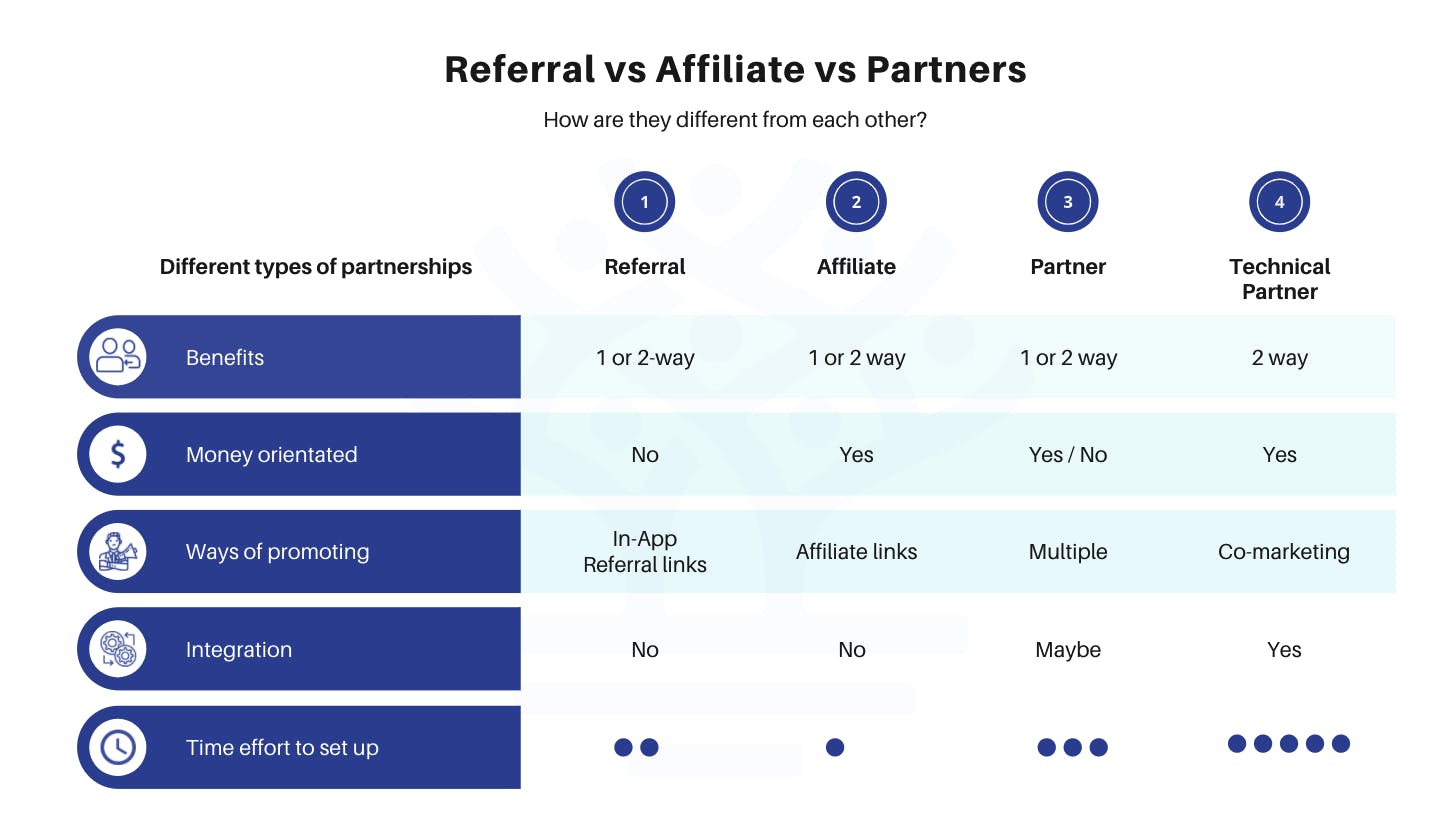
- SaaS Referral marketing entails a strong relationship between the parties, such as acquaintance or family connections.
- On the other hand, there is no established relationship between the affiliate and the individual who is referred in affiliate marketing. You formally engage bloggers, influencers, and other creative content developers as affiliates to market your SaaS products on their own channels through affiliate marketing. Each affiliate uses its own social media profiles, blogs, or websites to promote your website.
- Any collaboration with a third party that assists the marketing and/or selling of your products or services is referred to as channel partner marketing (also known as partner marketing). This third party could be an enterprise or an individual.
- Technical Partnership can be understood as building integration with another partner to get more clients.
Why do you need a SaaS affiliate program?
Why invest in the Indirect Marketing Distribution channel at all? Isn't the Direct Distribution channel sufficient to meet your promotional needs for gaining adequate traction?
The answer is No; the Direct Distribution channel is not enough. Here's why!
Your sales reps have roughly 5% of a prospect's time during their B2B buying journey. Besides, the present-day consumer is smart enough to spend time in research before investing in any product- and SaaS is no exception.
What is SaaS Affiliate / Partner Marketing?
To conclude; Affiliate marketing or partner marketing is a type of performance marketing. Under the scope of partner marketing, it is one of many powerful partnership-steered marketing strategies. Here, an individual (the affiliate who can be a blogger, YouTuber, IG influencer etc.) earns a commission for recommending an advertiser's product(s)/service(s) in affiliate marketing.
How it helps SaaS promotion
The strategy works in the following ways:
- It helps influence ICP prospects before they actually get in touch with you.
- Leverage the network of others to reach new markets
- Gain new backlinks
- Works on Pay-Per-Performance. So, there are no heavy marketing or upfront costs involved here. You pay only when they get you the lead.
How does SaaS affiliate marketing work?
Here is the operational flow of the normal SaaS marketing model:
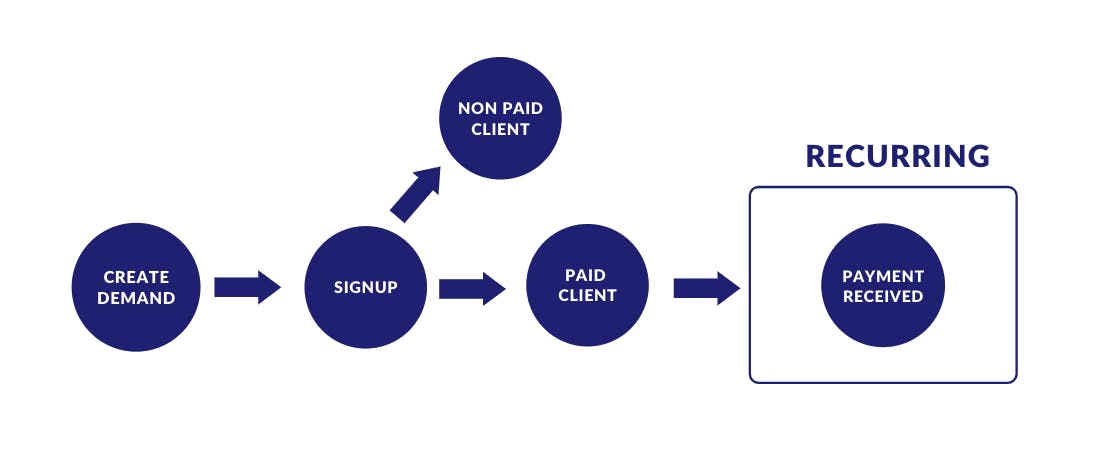
- You create demand for your SaaS solution
- People will visit your website and sign-up
- They have an option for a paid or unpaid subscription.
- When a paid subscription is activated, you'll receive the payout on a recurring basis (Monthly/yearly) from the client through their preferred transactional method.
Affiliate operational flow with an affiliate earning a commission
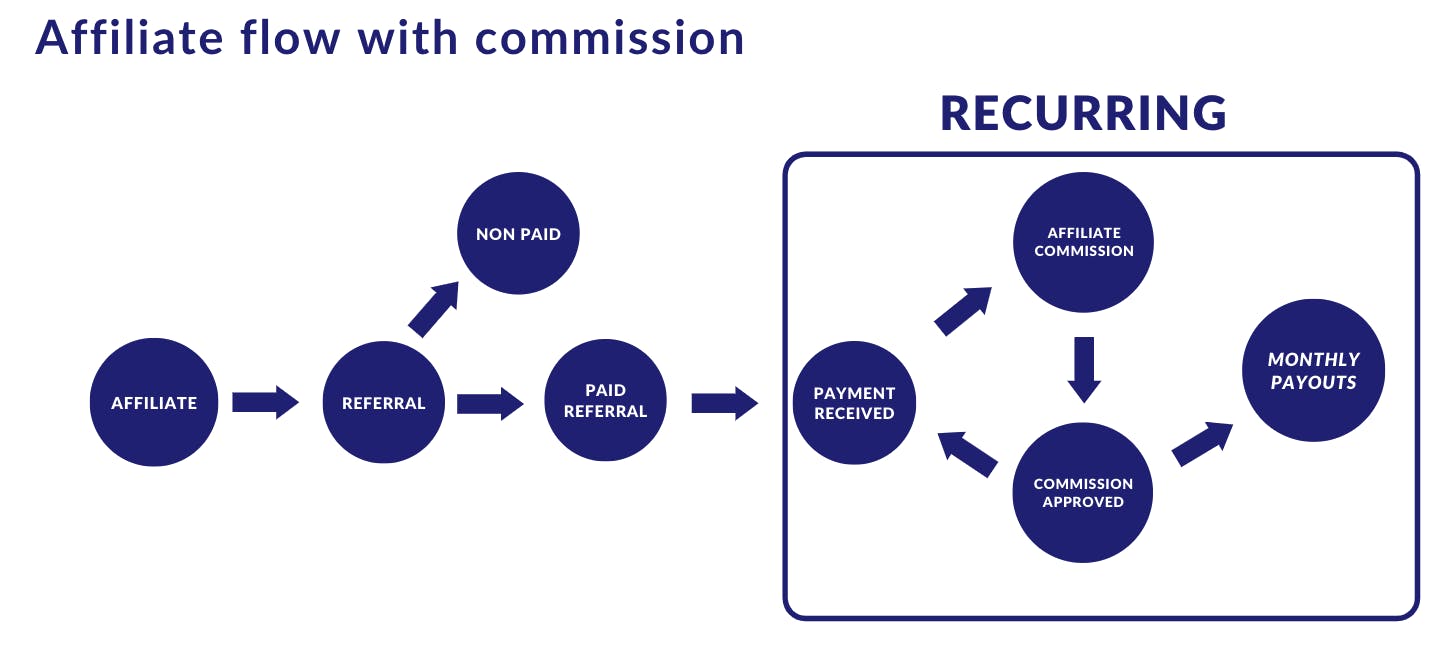
- Affiliate drives traffic to your website
- Prospects sign-up with paid/non-paid option
- When the sign-up is paid, a fixed percentage commission from the payout will go to the affiliate who directed the consumer to the website.
When your SaaS affiliate partners have a domain and they start promoting your product there, you are sure to get a big organic traffic boost through colossal networking.
Best time to start
It's when you have 'affiliate-market fit' alongside
- ICP and buying clients
- Ready branding material
- Individuals/companies willing to refer you
- Time on hand to grow a new revenue channel
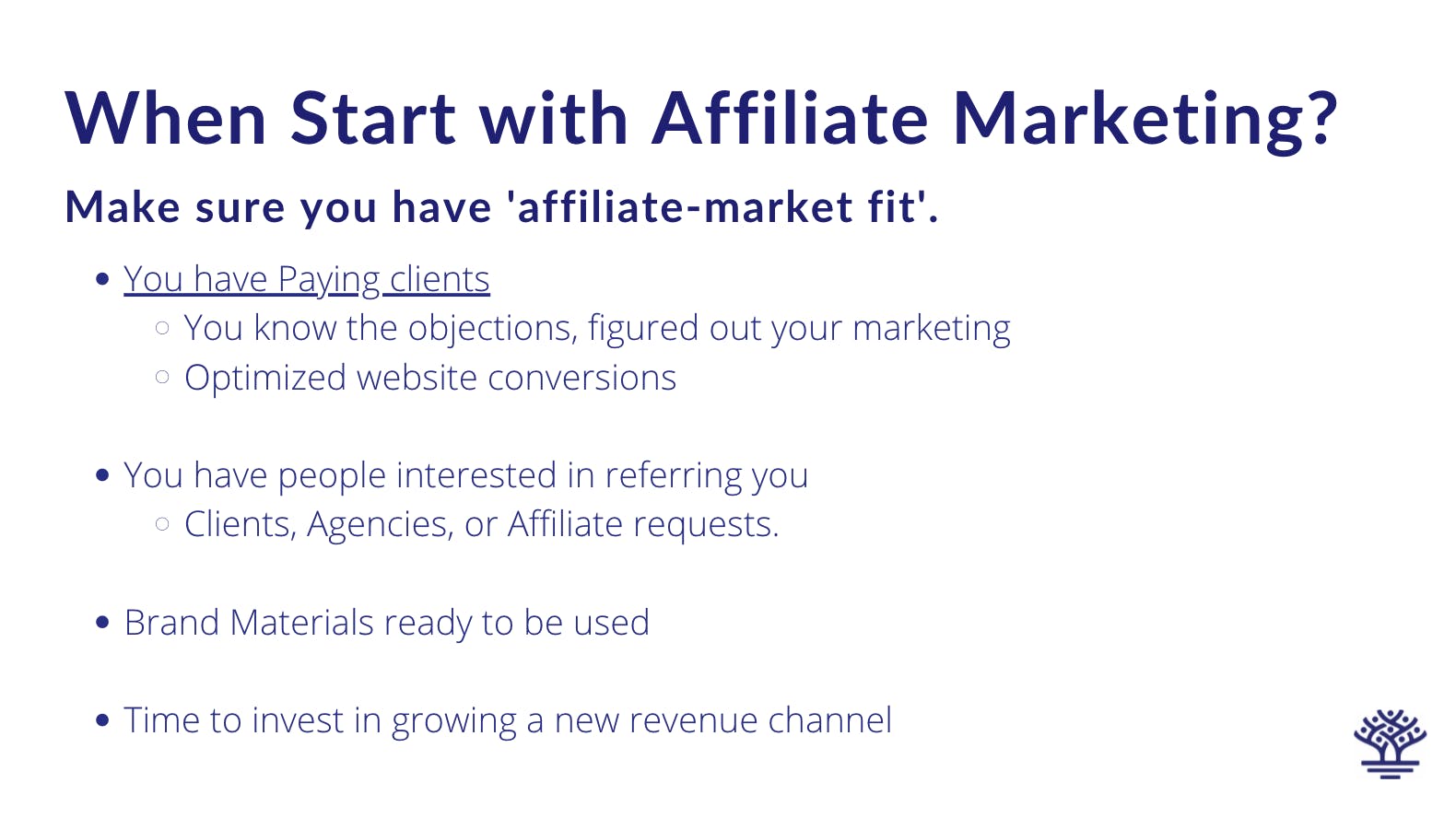
Choose of Partner Management Tool (PMT)
Choosing the right Partner Management Tool is important to determine the success of your program, and the overall growth of your Startup. You want to make sure the program helps you to succeed. When searching for these tools, you will be able to find a lot, with lots of different features. The main things you want to take a look at;
- Do they help you find a partner and grow your program?
- Do they offer SEO-friendly links?
- Do they help you to motivate partners?
- Are payouts to partners free?
- Is their pricing based on the value you are getting?
- Are they offering live chat support to your partners?
If one of the answers is no, they don't help you to grow your program in the most long-term way. When you already have a SaaS partner program, we do recommend switching tools, the longer you wait, the more difficult it becomes and the money you are missing out on.
We will dive into every question separately, to show you some examples of why you would really want to answer yes to all these questions.
Partner recruitment
Do they help you find a partner and grow your program?
A tool that helps you to recruit partners will allow you to gain partners outside of your own network. If they don’t offer this you will hit a ‘wall’ at one point where you dried out your network. Long term it would be best to look for a program that helps you find new partners.
This could be either with a marketplace or some kind of feature to attract partners. The partners who apply to you will be probably of more value, as they (hopefully) did their own research before applying to your program. Whereas when you invite SaaS partners, they need to learn everything from zero, as they might never hear of you before.
What kind of partners are on their platform?
Affiliate Marketing is already big in B2C, however, these are different kinds of partners. Focussing on B2B Partners who understand how the software works and how to sell it will make your program more profitable. We recommend going for a strong tool in the target group you are looking for.
Are you in B2B SaaS? Check out Reditus.
How do they help you qualify the partners?
In partner marketing it isn’t about the quantity of the partners, more about the quality. No matter what kind of partners you are looking for. It is always better to have real engaged partners which are generating money for you, instead of a huge number of partners with no activity.
This means you will need to vet / qualify the partners who want to join your program. A great way of doing this is to ask questions upfront. You can think about questions like this;
- Are you already using our software?
- Do you already have clients interested in our software?
- What is your monthly website traffic?
- Main reason for applying to our program?
We would recommend making them more specific when needed. Don’t ask too much though, as SaaS affiliate partners might not want to fill out a massive questionnaire to join your program.

SEO friendly links
This should be a no-brainer, however it isn’t the case at all SaaS partner management tools. Make sure you choose which offers SEO-friendly links, as it will help your marketing in general.
What does a SEO-friendly look like? It will show your domain with the tracking behind it, something like this; www.getreditus.com?trackingcode
Something you want to avoid is that the url does not directly refer to your own domain, as it would not give you any other benefit. SEO-friendly links are something that help you to improve your Domain Authority, the number of backlinks and traffic you are getting to the site. Even if you get 1.000 partners and no sales from them, you still receive new backlinks to your site which will help you grow organically.
Make sure you inform your partners to use certain ‘anchors’, which means the text a link is behind. Let's say we are looking to become the first result on google with an affiliate program, we would ask our partners to create and add the link behind those keywords. Making it look like this; affiliate program (it is the same link as above, but placed behind an ‘anchor’ with certain keywords.
Motivating partners
Once you have recruited partners you want to make sure they are generating you paid referrals. A Partner Management Tool (PMT) can help you to motivate your partners, for example by making sure partners keep logging into the tool. Some things a PMT can do for that is;
Allowing partners to run more programs in one overview
When a partner is able to run multiple programs in one affiliate platform they are more likely to come back, to see what happened per program. The more a partner logs in the more they will see your partner program and see what happened.
Notifications on important events
It is highly unlikely (even when they run multiple programs) a partner will log in every day by itself, a great way of having them to come back is with (email) notifications on important events. You can think about; new referral, new paid referral, commission earned and available payouts.
When they are able to show the partner notifications, you will stay more top of mind and it will help you to keep the partners motivated.
Multiple partner tiers
Creating multiple partner tiers is a great way to stimulate partners to do better. This is more applicable to the affiliates, as they are mostly focussed on the commission aspect. It will motivate SaaS affiliates to earn more commission if they do well, we recommend having them move up a tier based on paid referrals.
See an example below on how this could look in practise:

Free Partner Payouts
When your partners start delivering you paid referrals and they are eligible to receive their commission, you don’t want to have extra costs related to that. Some tools will charge a certain % commission on the payouts you do to partners, next to the subscription costs you already have.
This will continue with the next question to check.
Pricing based on value
As you hopefully already know, it is important to measure certain metrics within your SaaS. Two of these are; LTV & CAC. LTV stands for Lifetime Value and CAC for Customer Acquisition Costs.
Related; See more SaaS terms
When you measure, you know exactly what the value of a new client is (LTV) and how much it costs to attract new ones (CAC). If you would put these together you will get LTV:CAC, which gives an indication on how profitable your business is.
When your PMT asks for a high implementation fee, starting fee or any other high upfront costs it will be hard to keep your ratio ‘healthy’. Ideally a PMT will grow with you based on the value they provide.
For example, at Reditus you start with a subscription of $39 per month (on an annual basis) and you won’t have any additional costs. Keeping your tool costs for year one at; $468. Often it means you only need to get 1-2 paid clients to cover those costs, meaning anything extra will cover additional costs and will make you profitable.
When you are doing well, a tool will start charging more, at that point you will always have a real healthy ratio between money earned vs subscription price.
Check out the pricing of Reditus.
Define your partner program
Why should a partner join your program, and more importantly, why should they keep bringing you new paid referrals? If you are able to incentivise them properly it would help a lot on your long-term goals of the program.
A great way to do this is to have them work to a new tier. When a new partner hits a certain threshold the commission % and length will change. More discussed above in choosing your partner program.
Another option could be to have people do certain things to receive better benefits. You can think of the following;
- Write a review(s) on G2, Capterra, Trustradius etc.
- Write a blog with a mention to your page
- Complete your partner training
- Send out a newsletter with a mention to you
You get the idea; Do X for us and you will receive Y. This will help the partner to kickstart their program and receive better benefits, with the both of you as a winner in the end.
How much commission should I give?
This answer will be different for every SaaS, however we will give you some metrics and things to consider when you determine your commission percentage and length.
First of all, LTV:CAC will be an important one. It is great when you already know your LTV it will make things easier to calculate this. As your Customer Acquisition Costs will be different from the other channels you are running you might want to make an estimation for this when you start out. Start writing out all the 12 month costs related to running a partner program, hereby some things to include;
- How much FTE is internally spend on the program, and what is the related costs
- How much does the Partner Management Tool cost
- How much commission do you think you will give away, and for how long
- Mow much additional costs do you have? (for example; marketing materials)
When you have added these costs in a sheet you would want to make an estimation on how much paid referrals you are expecting in the next 12 months. This will help you to make an estimation on your CAC for your partner program.
In the end, the partners will need to do the work, so remember they need to be motivated by the money they are earning when referring to paid clients.
Define your ideal partners
In the beginning of this article we already discussed the different types of partnerships you can have when running a SaaS. Within these types you could also think about what the Ideal Partner Profile is for you; As it is about quality and not quantity.
When you are starting out you might not know yet, accepting everyone and finding it out along the way could be an option. When you already want to qualify them, see here some ideas to think about;
- Type; What kind of partner is it
- Location; Where are the partners located
- Network; How big is their network / reach
- Potential; What is the growth potential of this partner
- Co-marketing; Are there any other benefits of partnering with them, for example doing webinars, email lists they have, blogs they write etc.
- Knowledge; are they already using your software?
Partner Motivators
You might already look at this when defining your ideal partners, however, it is essential to keep in mind what a partner is looking for. What keeps them motivated? We discussed the multiple tiers, where a partner can earn more money when doing well.
What however, if they don’t do it for the money? See below a list of some motivators a partner can have;
- Money; this will be for the affiliate marketers, smaller agencies, and consultants. We do recommend offering more money when they are doing well. See the multiple-tier part in the section above.
- Value for customers; Agencies that care less about the money want to ensure their clients get value from your tool. They want to make sure their clients reach their goals with the tools they recommend.
- Leads; When you create a two-way lead system, where you also pass leads to the agencies, you will help them grow as well. This often is a great motivator to stay with your tool, as it is a real partnership and they will lose out on new business when they leave.
- Co-Marketing; When you are a well-established brand, partners want to be ‘seen with you’, if they can lift on your brand they will be motivated to do better. Some ideas; add them in newsletters, webinars, case studies, exhibitions etc.
- Education program; Offering an education program explicitly for partners will help them to grow their knowledge and improve their skills. A clear win-win as they will deliver better results and are more motivated as you helped them to grow.
- Certifications; You want to make sure partners understand your product; on the other hand partners want to show how ‘skilled’ they are. Offering certifications will make sure they follow your brand guidelines and will allow them to show something to their clients. Hubspot is an excellent example of this, where you can get yourself certified.
Set Goals / Define Success Factors
One part which you should never forget (with anything you do) is to define goals, when is something you do a success? The goals might be different for the type of partnership you are looking for, the more specific you make them, the better though.
See below some examples of goals you could set for affiliate marketers and agencies joining your partner program. Make sure you focus on the ‘right’ metrics, the ones which are actually driving your business value or money.
Affiliate Marketing goals
Reminder, when working with affiliate partners they often do not talk to their clients. Meaning the referrals are not qualified by them, as they focus on volume. Also their main focus is to generate money and might switch to a competitor when they offer a better deal. Keep this in mind when you are setting your goals. So saying we want 150 partners doesn’t make any sense, as they might not do anything.
- We want to generate 50 paid referrals in the first 12 months of our affiliate program.
- We want to grow the affiliate program to $5.000 MRR in the first 12 months
- We want to have 100 partners within 12 months who generate at least 10 signups per month for us. (this one might not be as qualified as the others as you can see).
Get the point? When you calculate your LTV:CAC it becomes easier to decide when your program is a success or not.
3. Promote your partner program
Only pay for each performance. Increase your SaaS revenue by maintaining a strong LTV: CAC ratio!
How to build an effective affiliate program?
Growing your SaaS can be complicated and inflexible, as you expend money on marketing without knowing what you'll get in return.
Affiliate marketing is a sort of pay-per-performance marketing in which you only pay a commission for paid clients.
Elevate your LTV: CAC ratio to a healthy level, and your SaaS is sure to thrive in the long run.
Like most things within SaaS, it is easy to build, however to market it might be the hardest part. This will be no different, however, you can make quick wins by following the suggestions below.
Mention it on your website
When agencies and influencers are looking at your website they might be actively looking if you offer a partner program. The best practice is to mention it at least in the footer, as this is the place a lot of people will look first.
Adding a bigger visual could also work, as every visitor is aware of it and can immediately register if deemed fit. If that is not what you are looking for, you probably want to put the details in the footer only and link it to the page that explains the program and enrolment nitty-gritty.

Another way would be to add this to your navigation menu at the top. An example of this how to do this so no one misses it is as follows;
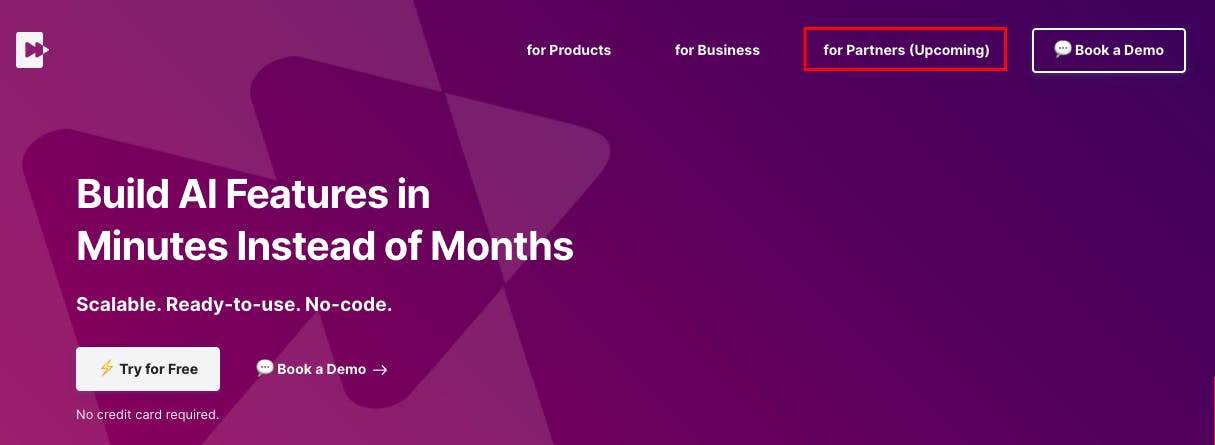
This might be over the top for some companies and distracting from people signing up. So we would only recommend doing this when a lot of your visitors are looking for a partner program. This would be the case when you are targeting agencies for example.
Once you have mentioned it on your site people have to go somewhere, the best thing to do is to explain more about your program before you have them apply.
Create a dedicated partner program page
When you have people clicking the footer or navigation link, they will need to end up somewhere. To make sure they become a partner they would like to know more information about your program first.
At Reditus we do provide landing pages where you can add some information, however, we do recommend showing them a bit more first. See a great example from Scalenut below, where they inform + have CTA's at the top to convert people who are still interested. Do you also see how they mention the commission tiers?
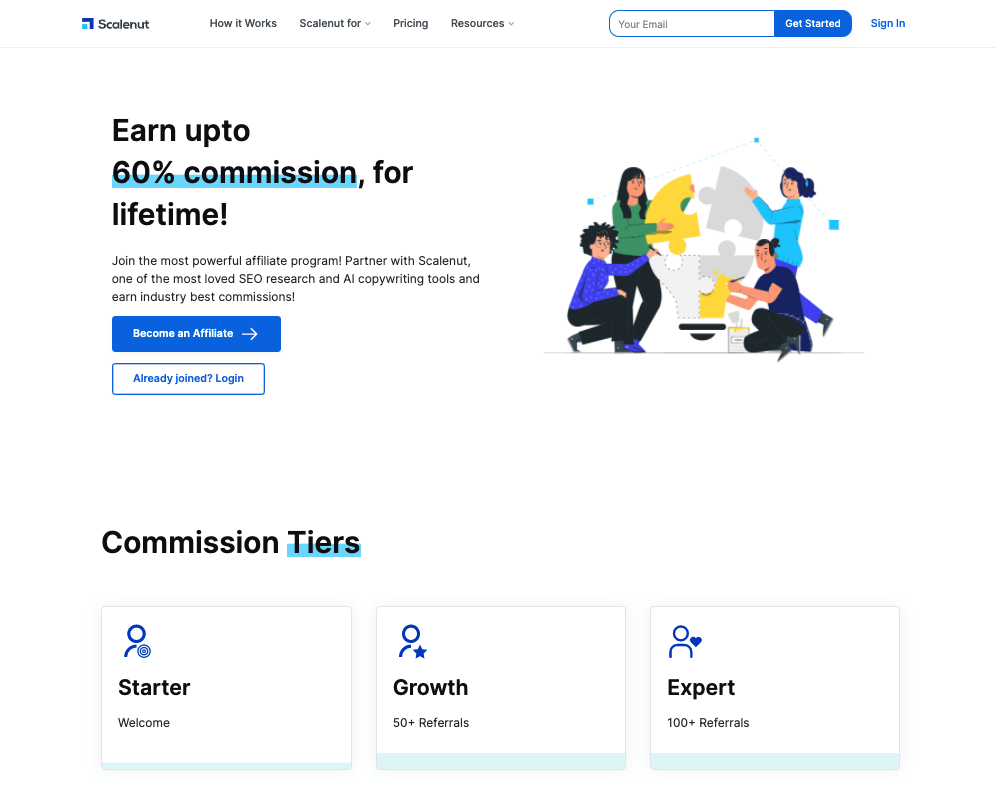
Existing clients/users
You may have heard that your best salespeople are your clients. As true as it is, this is the most undervalued method of obtaining affiliates for your SaaS product.
A satisfied consumer is more likely to recommend your product to relatives and friends, and what could be better than receiving money while doing so?
Now, there's a good probability that your customer uses Facebook, and according to studies, the average Facebook user has 155 friends.
This straightaway indicates your customer can recommend your product to 155 individuals he or she knows and trusts.
Gain affiliate through recruiting
Influencers are a rage these days, and it's evident in every marketing conference and blog. They are people who have a large following due to their expertise or popularity in a particular niche. Actors, artists, and even stay-at-home dads are all possibilities.
You may greatly enhance your sales by utilizing influencer reach, picking a good product based on the platform, and providing high-quality marketing material.
Next comes the recruiting of niche bloggers. When people are passionate about something, they frequently establish a blog. Suppose a person's hobby is reviewing software. In that case, a blog is a good way to share expertise and attract like-minded others looking for software information on the internet.
Most of the time, if a person is skilled at something and gives useful information on his or her blog to help other people who share the same interest, the blog will become rather popular among those who share a similar inclination. Using these well-established blogs as a starting point for affiliate marketing is a fantastic idea.
Leveraging affiliate management tools
Marketers frequently use affiliate management tools to locate goods or services to advertise. In addition, when you join such a network, there's a considerable likelihood that willing associates may approach you rather than you approaching them.
When listing on these networks, it becomes vital to make sure you have a competitive commission structure and generous incentives.
You may also need to supply your affiliates with advertising material such as banners or graphics.
You can also locate affiliate program directories to advertise your program in addition to these platforms.
See the Reditus SaaS Marketplace as a great example.
Contact Competitor Affiliates
Affiliates for your rivals make money by bringing traffic to the selling website and receiving a commission on any sales generated by those referrals. Affiliates do this by linking to your competitor's landing page (or product page), which is technically an inbound hyperlink to your competitor's website. When we click on those links, we can see who the affiliates are, and you can get all of that information with just a few clicks.
Want to get a full list of all your competitor partners? Check out the backlinks in SEO tools to find them all. Contact us if you need help with this.
Receiving Partner Requests
Once all is set, it's time to receive partner requests. There are basically three steps you need to follow:
- Ask questions
- Qualify partners
- Accept/Decline
Quality affiliates are well-versed in your product line and can come up with novel ways to promote them. They consistently create valuable and engaging content for their audiences, and they're eager to learn and adapt as your campaigns are evaluated and modified.

Keep your affiliates motivated
It takes a thoughtful approach – and one that drives them – to persuade your inactive affiliates to give you another shot. We'll now look at three strategies that should be of assistance.
1. Send Affiliate Newsletters on a Regular Basis to Encourage interaction
You can communicate with your affiliates via email on a regular basis using an affiliate newsletter. This is beneficial in inspiring your affiliates because it demonstrates your willingness to assist them. Here are some pointers to get you started:
- Make a schedule for yourself and stick to it. It's entirely up to you how often you distribute the newsletter. Monthly, on the other hand, is a common choice.
- Each newsletter should feature great affiliates. The goal is to promote the affiliates you think will entice even the most apathetic members to join. They don't have to be the top sellers (though they can be), but they should be the ones who have improved the most from month to month.
2. Offer Incentives to Boost Affiliate Performance
In a nutshell, incentives are monetary benefits you give to your affiliates. Performance-based (for selling a particular quantity) and recruitment-based incentives are two types of incentives (for bringing new affiliates to the program). The advantages for your affiliates are evident, as incentives provide them with a financial incentive to focus on your program. They also provide you an advantage over any competing programs with which your affiliates may be involved.
Of course, there are numerous ways to provide rewards. You can do the following:
- Create an incentive that is only valid for a limited time. For instance, you may run an offer that says, "Make your first sale within 30 days and get a 5% bonus." This is an excellent strategy to increase sales in a short amount of time.
- Incentives should be widely advertised- In addition to affiliate newsletters and your affiliate dashboard, you should communicate rewards with your affiliates in every way feasible.
- You should also reconsider your present commission rate. Another reason your affiliates are becoming inactive could be because it isn't competitive enough.
3. Provide the Tools Affiliates Need to Do Their Job Easily
The better your affiliates operate, the better your business performs. You can make their job easier and enhance their effectiveness by providing key tools like banner makers and link shorteners. A resource hub with a range of tools can also provide just what affiliates need to get started if they are too afraid or busy to ask for assistance.
Providing a centralized resource like this demonstrates that you care about your affiliates' success and will provide the support they require. Don't forget to do the following:
Your affiliate dashboard should include a link to your resource hub. As a result, all affiliates have easy access to the tools. Include a page with frequently asked questions. This may provide answers to some of the most frequently asked questions by your inactive affiliates.
- Keep track of the right metrics
- Drive growth with the right partners

